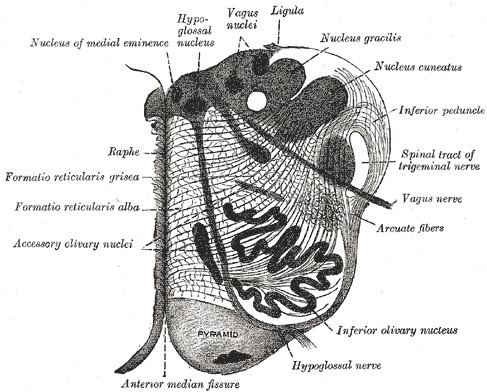Latin nuclei raphe Dorlands
/Elsevier n_11/12582773 | NeuroLex ID Raphe Nuclei FMA 84017 | |
 | ||
MeSH A08.186.211.132.659.632 TA A14.1.04.257
A14.1.04.318
A14.1.05.402
A14.1.05.601
A14.1.06.401 | ||
The raphe nuclei (Greek: ῥαφή "seam") are a moderate-size cluster of nuclei found in the brain stem. Their main function is to release serotonin to the rest of the brain. Selective serotonin reuptake inhibitor (SSRI) antidepressants are believed to act in these nuclei, as well as at their targets.
Contents
Anatomy
The raphe nuclei are traditionally considered to be the medial portion of the reticular formation, and appear as a ridge of cells in the center and most medial portion of the brain stem.
In order from caudal to rostral, the raphe nuclei are known as the nucleus raphe obscurus, the nucleus raphe pallidus, the nucleus raphe magnus, the nucleus raphe pontis, the median raphe nucleus, dorsal raphe nucleus, caudal linear nucleus. In the first systematic examination of the raphe nuclei, Taber et al.. (1960) originally proposed the existence of two linear nuclei (nucleus linearis intermedius and nucleus linearis rostralis). This study was published before techniques enabling the visualization of serotonin or the enzymes participating in its synthesis had been developed, as first demonstrated by Dahlström and Fuxe in 1964. Later, it was revealed that of these two nuclei, only the former (nucleus linearis intermedius, now known as the caudal linear nucleus), proved to contain serotonin-producing neurons, though both of them contain dopaminergic neurons.
In some works (e.g.), researchers have grouped the nuclei lineares into one nucleus, the nucleus linearis, shrinking the number of raphe to seven, e.g., NeuroNames makes the following ordering:
Nomenclature
The Latin names commonly used for most of these nuclei are grammatically and orthographically incorrect. Latin grammar would require to use the genitive case raphes ('of the seam') instead of the nominative case raphe ('seam') in these Latin expressions. The main authority in anatomical names, Terminologia Anatomica uses for example nucleus raphes magnus instead of the grammatically incorrect nucleus raphe magnus. The spelling raphe/raphes however can also be contested as numerous sources indicate that raphe is an incorrect Latin rendering of the Ancient Greek word ῥαφή as the initial letter rho with rough breathing (spiritus asper) is normally rendered as rh in Latin. The edition of the Nomina Anatomica that was ratified in Jena in 1935 used rhaphe instead of raphe.
Projections
These nuclei interact with almost every pertinent portion of the brain, but only a few of them have specifically independent interaction. These select nuclei are discussed as follows.
Overall, the caudal raphe nuclei, including the nucleus raphe magnus, nucleus raphe pallidus and nucleus raphe obscurus, all project towards the spinal cord and brain stem. The more-rostral nuclei, including the nucleus raphe pontis, nucleus centralis superior (also called median raphe nucleus) and nucleus raphe dorsalis project towards the brain areas of higher function
However, studies also show that numerous areas of the brain control the serotonergic neurons located in the nucleus raphe dorsalis, including the orbital cortex, cingulate cortex, medial preoptic area, lateral preoptic area, and several areas of the hypothalamus. The connection between these areas, particularly between the nucleus raphe dorsalis and the orbital cortices, is thought to have influences on depression and obsessive compulsive disorder prognosis.
Function
The raphe nuclei have a vast impact upon the central nervous system. Many of the neurons in the nuclei (but not the majority) are serotonergic; i.e., contain serotonin, a type of monoamine neurotransmitter and are modulated through fibrous pathways in the midbrain.
Projections from the raphe nuclei also terminate in the dorsal horn of spinal gray matter where they regulate the release of enkephalins, which inhibit pain sensation.
The raphe nuclei provide feedback to the suprachiasmatic nuclei (SCN), thus contributing in circadian rhythms in animals. The SCN transmits to the raphe nuclei via the dorsomedial hypothalamus nucleus altering serotonin levels for sleep/wake states. The raphe nuclei will then transmit feedback to the SCN about the animal's vigilance and levels of alertness. This reciprocal feedback between the two structures provides an adaptable yet stable basis of circadian rhythms.
The raphe nuclei and the effects of ghrelin
More recent studies of the Raphe Nuclei done with rats involve the effects of Ghrelin on the dorsal raphe nucleus. When administered, larger doses of Ghrelin act centrally on the raphe nucleus, hippocampus, and amygdala which causes dramatic increases in food intake, memory retention, and increases in anxiety. The effects of ghrelin are seen on the raphe nucleus as soon as an hour after injection, suggesting rapid changes in the nucleus' structure. Changes also occur after 24 hours suggesting delayed modifications as well.
